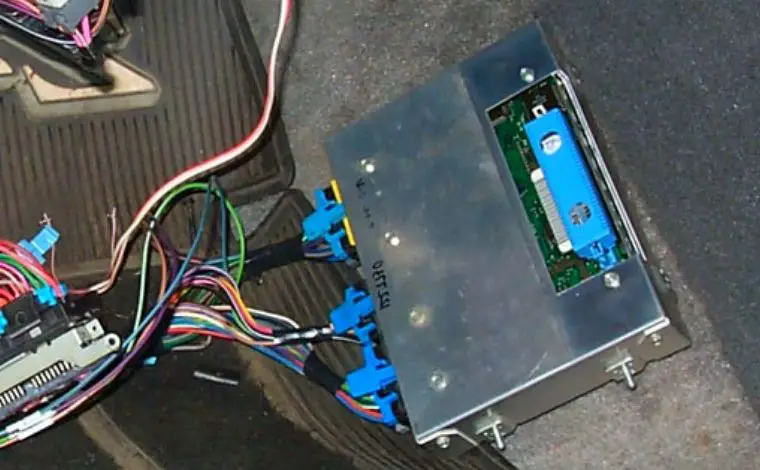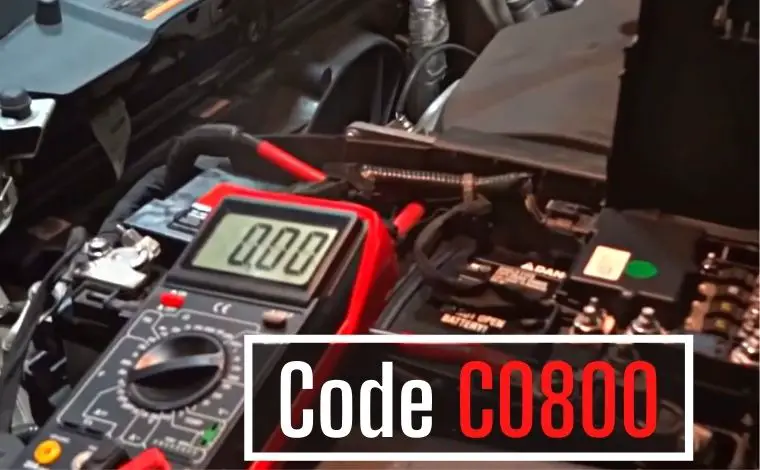Last Updated on March 26, 2025
When your OBD-II scanner displays the C0800 code, it indicates a chassis-related issue specifically involving the control module power circuit. This error can trigger warning lights such as the Check Engine Light or ABS Light, often leading to confusion. However, the presence of this code points to a serious electrical malfunction that needs immediate attention to avoid further vehicle damage or performance issues.
🚨 Common Causes of the C0800 Code
- Low battery voltage or a completely dead battery
- Corroded or loose battery terminals
- Damaged wiring or connectors in the ECM power supply circuit
- Blown fuse or tripped circuit breaker related to the ECM
- Malfunctioning alternator not properly charging the battery
- Faulty control modules (e.g., Body Control Module (BCM) or Engine Control Module (ECM))
🛠️ Quick Fixes and Solutions
- Inspect and test the battery and charging system
- Check wiring and connectors for signs of wear, corrosion, or disconnection
- Examine related fuses and relays in the power distribution box
- Ensure all ground connections are clean and properly fastened
- Review the power steering system, as some chassis codes can overlap
- Scan for additional trouble codes for more accurate diagnosis
- Perform a visual inspection of the control modules
- Check for manufacturer Technical Service Bulletins (TSBs)
- Seek help from a certified technician if needed
- Clear the code and test-drive the vehicle to confirm resolution

🔌 What Is a Control Module Power Circuit?
The control module power circuit, often referred to as the Powertrain Control Module (PCM), is the central unit responsible for managing various vehicle systems. It integrates two critical components:
- Engine Control Unit (ECU)
- Transmission Control Unit (TCU)
Together, these manage everything from fuel injection and ignition timing to shift points and throttle response. A failure in this system can result in poor engine performance, stalling, or failure to start.
⚙️ Detailed Causes of the C0800 Code
1. Faulty Control Module Power
If the module becomes damaged or fails internally, it may not transmit power properly, leading to system-wide failures and a triggered C0800 code.
2. Poor or Corroded Electrical Connections
Loose, damaged, or corroded electrical terminals can restrict the module’s power supply. This causes intermittent functionality or complete failure.
3. Increased Fuel Consumption
An imbalanced or malfunctioning control module may cause the engine to use more fuel than needed. This results in reduced efficiency and unnecessary expenses.
4. Voltage Irregularities
Voltage that is too high or too low affects how the PCM operates. If the module doesn’t receive a stable power supply, it may misfire or shut down temporarily.
5. Open or Shorted Power Harness
A frayed or broken power harness can interrupt the signal between key components. This disruption can result in C0800 or other related diagnostic codes.
🛠️ How to Fix the C0800 Error Code
The C0800 trouble code indicates a malfunction in your vehicle’s control module power circuit. This issue can cause poor electrical connectivity and lead to significant drivability problems. Here’s how to approach diagnosing and resolving the C0800 code effectively:
🔍 Step 1: Identify the Problem
Begin by thoroughly inspecting the vehicle’s electrical system. If you’re knowledgeable about electrical systems, you may be able to perform a basic check for poor connections, corrosion, or loose wires. If not, it’s highly recommended to consult a professional technician or automotive electrician.
🧪 Step 2: Confirm the Error Code
Use an OBD-II scanner to read the exact error code. If the scanner shows C0800, it confirms that the issue is related to the control module power circuit. This eliminates guesswork and ensures you’re targeting the correct system for repairs.
🧰 Step 3: Perform Repairs
Once the issue is identified, the faulty component should be repaired or replaced. Common repairs include:
- Replacing corroded or loose connectors
- Repairing damaged wiring in the power circuit
- Replacing a malfunctioning control module (such as the BCM or ECM)
- Installing a new fuse or relay if the existing one is blown
If you’re not experienced in electrical diagnostics, take your vehicle to a certified mechanic to avoid causing further damage.
🔄 Step 4: Recheck for the Code
After the repair, clear the code using your scanner and take the vehicle for a test drive. Then, re-scan the system. If C0800 does not reappear, the issue is resolved. If it persists, there may be an overlooked problem or deeper issue that requires expert diagnosis.
🧾 Summary: What Does the C0800 Code Really Mean?
The C0800 code is a chassis-related diagnostic trouble code (DTC) tied to the power supply of the control module. This module controls key systems like fuel, ignition, and electrical communication within your vehicle. When it malfunctions, it can lead to:
- Poor fuel efficiency
- Electrical instability
- Unreliable performance
Ignoring the code can lead to further engine damage or unexpected vehicle failure. Prompt diagnosis and repair are crucial for maintaining a smooth and safe ride.
🚗 Final Thoughts
Fixing the C0800 control module power circuit error not only improves your car’s performance but also enhances fuel efficiency and safety. While you may need to spend on repairs initially, you’ll likely save more by avoiding excessive fuel consumption and preventing costly breakdowns. After fixing the issue, always ensure the engine warning light turns off. If not, revisit your mechanic to ensure everything is thoroughly resolved.
🧩 Related Codes You Might Encounter
For additional insights into similar or connected error codes, explore:
- 🔧 C0300 Code: Rear Prop Shaft Speed Sensor Malfunction
- ⚙️ C0550 Code: Control Module Performance
- 🧭 C0710 Code: Steering Angle Sensor Circuit
Kevin Nicholas is an automotive technician who is a genius at software and hardware-related issues. He manually tested more than a hundred OBD scanners and gave his honest opinion on whether the device was worth the money or not. His in-depth OBD review articles help people choose the right product, whether it is a European, American, or Asian vehicle. He completed his Automotive Specialized Training Course at Universal Technical Institute and has more than 15 years of experience in the field.

